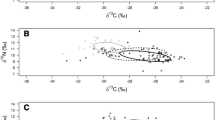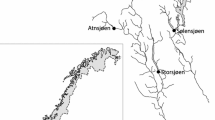Abstract
Nonnative trout invasions have caused the widespread decline of cutthroat trout populations in western North America. In contrast to other nonnative salmonids, the role of nonnative brown trout in native cutthroat trout decline is poorly understood. Specifically, the level of ecological similarity that occurs between these species and the importance of other trophic mechanisms (e.g., predation) in their interactions are key uncertainties. We evaluated the trophic relationships of brown trout and cutthroat trout in a northern Utah river using a combination of diet and stable isotope analyses. We compared the dietary habits of these two species using multiple and complementary measures. Based on both stomach contents and δ13C signatures, we found that these species consumed a similar and opportunistic diet (i.e., they were nonselective in their foraging patterns). However, at most sizes, brown trout ingested larger prey—including fishes—and occupied a higher relative trophic position (i.e., δ15N) than cutthroat trout. Overall, these results demonstrate a high degree of dietary similarity and therefore strengthen earlier conclusions regarding interspecific competition between these two species. Our study, when considered alongside the work of others, suggests there is potential for predatory interactions between these species (i.e., brown trout preying on small cutthroat trout). We believe that future research on brown trout–cutthroat trout interactions should consider predatory effects in greater detail.




Similar content being viewed by others
Notes
http://water.usgs.gov, gauge number 10109000
References
Allen JD, Russek E (1985) The quantification of stream drift. Can J Fish Aquat Sci 38:184–192
Bachman RA (1984) Foraging behavior of free-ranging wild and hatchery brown trout in a stream. Trans Am Fish Soc 113:1–32
Baxter CV, Fausch KD, Murakami M, Chapman PL (2004) Fish invasion restructures stream and forest food webs by interrupting reciprocal prey subsidies. Ecology 85:2656–2663
Beaudoin CP, Tonn WM, Prepas EE, Wassenaar LI (1999) Individual specialization and trophic adaptability of northern pike (Esox lucius): an isotope and dietary analysis. Oecologia 120:386–396
Birch LC (1957) The meanings of competition. Am Nat 91:5–18
Budy P, McHugh P, Thiede GP (2004) Logan River whirling disease study: factors affecting trout population dynamics, abundance, and distribution in the Logan River, Utah. Annual Report to Utah Division of Wildlife Resources, Utah Cooperative Fish and Wildlife Research Unit, Logan, 61 pp
Budy P, Thiede G, McHugh P (in press) A quantification of the vital rates, abundance, and status of a critical population of endemic cutthroat trout. N Am J Fish Manag
Cartwright MA, Beauchamp DA, Bryant MD (1998) Quantifying cutthroat trout (Oncorhynchus clarki) predation on sockeye salmon (Oncorhynchus nerka) fry using a bioenergetics approach. Can J Fish Aquat Sci 55:1285–1295
Cortés E (1997) A critical review of methods of studying fish feeding based on analysis of stomach contents: application to elasmobranch fishes. Can J Fish Aquat Sci 54:726–738
Dunham JB, Rahn ME, Schroeter RE, Breck SW (2000) Diets of sympatric Lahontan cutthroat trout and nonnative brook trout: implications for species interactions. West N Am Nat 60:304–310
Dunham J, Adams SB, Schroeter R, Novinger D (2002) Alien invasions in aquatic ecosystems: toward an understanding of brook trout invasions and their potential impacts on inland cutthroat trout in western North America. Rev Fish Biol Fish 12:373–391
Fausch KD (1988) Tests of competition between native and introduced salmonids in streams: what have we learned? Can J Fish Aquat Sci 45:2238–2246
Fausch KD (1989) Do gradient and temperature affect distribution of, and interactions between juvenile brook char and other salmonids in streams? Physiol Ecol Jpn 1(Spec Vol):303–322
Fausch K (1998) Interspecific competition and juvenile Atlantic salmon (Salmo salar): on testing effects and evaluating evidence across scales. Can J Fish Aquat Sci 55(Suppl. 1):218–231
Fausch KD, Nakano S, Kitano S (1997) Experimentally induced foraging mode shift by sympatric charrs in a Japanese mountain stream. Behav Ecol 8:414–420
Fuller PL, Nico LG, Williams JD (1999) Nonindigenous fishes introduced into inland waters of the United States. American Fisheries Society, Bethesda
Griffith JS (1974) Utilization of invertebrate drift by brook trout (Salvelinus fontinalis) and cutthroat trout (Salmo clarki) in small streams in Idaho. Trans Am Fish Soc 103:440–447
Griffith JS (1988) Review of competition between cutthroat trout and other salmonids. Am Fish Soc Symp 4:134–140
Hilderbrand RH, Kershner JL (2004) Influence of habitat type on food supply, selectivity, and diet overlap of Bonneville cutthroat trout and nonnative brook trout in Beaver Creek, Idaho. N Am J Fish Manag 24:33–40
de la Hoz Franco EA, Budy P (2005) Effects of biotic and abiotic factors on the distribution of trout and salmon along a longitudinal stream gradient. Environ Biol Fish 72:379–391
Kara C, Alp A (2005) Feeding habits and diet composition of brown trout (Salmo trutta) in the upper streams of River Ceyhan and River Euphrates in Turkey. Turk J Vet Sci 29:417–428
Koel TM, Bigelow PE, Doepke PD, Ertel BD, Mahony DL (2005) Nonnative lake trout result in Yellowstone cutthroat trout decline and impacts to bears and anglers. Fisheries 30:10–19
Kreivi P, Muotka T, Huusko T, Mäki-Petäys A, Huhta A, Meissner K (1999) Diel feeding periodicity, daily ration, and prey selectivity in juvenile brown trout in a subarctic river. J Fish Biol 55:553–571
L’Abée-Lund JH, Aass P, Saegrov H (2002) Long-term variation in piscivory in a brown trout population: effect of changes in available prey organisms. Ecol Fresh Fish 11:260–269
Matthews B, Mazumder A (2004) A critical evaluation of intrapopulation variation in δ13C and isotopic evidence of individual specialization. Oecologia 140:361–371
Mayama H (1999) Predation of juvenile masu salmon (Oncorhynchus masu) and brown trout (Salmo trutta) on newly emerged masu salmon fry in the Chitose River. Bull Natl Salmon Resour Cent 2:21–27
McCune B, Grace JB (2002) Analysis of ecological communities. MjM Software, Gleneden Beach
McGrath CC (2004) Trophic roles of native greenback cutthroat trout and non-native brook trout in montane streams of Colorado. Dissertation, University of Colorado, Boulder
McHugh P, Budy P (2005) An experimental evaluation of competitive and thermal effects on brown trout (Salmo trutta) and Bonneville cutthroat trout (Oncorhynchus clarki utah) performance along an altitudinal gradient. Can J Fish Aquat Sci 62:2784–2795
McHugh P, Budy P (2006) Experimental effects of nonnative brown trout (Salmo trutta) on the individual- and population-level performance of native Bonneville cutthroat trout (Oncorhynchus clarkii utah). Trans Am Fish Soc 135:1441–1455
McIntosh AR (2000) Habitat- and size-related variations in exotic trout impacts on native galaxiid fishes in New Zealand streams. Can J Fish Aquat Sci 57:2140–2151
Metzeling L, Robinson D, Perriss S (2002) Temporal persistence of benthic invertebrate communities in south-eastern Australian streams: taxonomic resolution and implications for the use of predictive models. Mar Freshw Res 53:1223–1234
Milliken GA, Johnson DE (2000) Analysis of messy data, volume III: analysis of covariance. Chapman and Hall, Boca Raton
Milner AM, Conn SC, Brown LW (2006) Persistence and stability of macroinvertebrate communities in streams of Denali National Park, Alaska: implications for biological monitoring. Freshw Biol 51:373–387
Mittelbach GG, Persson L (1998) The ontogeny of piscivory and its ecological consequences. Can J Fish Aquat Sci 55:1454–1465
Museth J, Borgstrøm R, Hame T, Holen LÅ (2003) Predation by brown trout: a major mortality factor for sexually mature European minnows. J Fish Biol 62:692–705
Nakano S, Fausch KD, Kitano S (1999) Flexible niche partitioning via a foraging mode shift: a proposed mechanism for coexistence in stream-dwelling charrs. J Anim Ecol 68:1079–1092
Novinger DC (2000) Reversals in competitive ability: do cutthroat trout have a thermal refuge from competition with brook trout? Dissertation, University of Wyoming, Laramie
Novinger DC, Rahel FJ (2003) Isolation management with artificial barriers as a conservation strategy for cutthroat trout in headwater streams. Conserv Biol 17:772–781
Overman NC, Parrish DL (2001) Stable isotope composition of walleye: 15N accumulation with age and area-specific differences in δ13C. Can J Fish Aquat Sci 58:1253–1260
Post DM (2002) Using stable isotopes to estimate trophic position: models, methods, and assumptions. Ecology 83:703–718
Quist MC, Hubert WA (2004) Bioinvasive species and the preservation of cutthroat trout in the western United States: ecological, social, and economic issues. Environ Sci Policy 7:303–313
Quist MC, Hubert WA (2005) Relative effects of biotic and abiotic processes: a test of the biotic–abiotic constraining hypothesis using cutthroat trout. Trans Am Fish Soc 134:676–686
Rader RB (1997) A functional classification of the drift: traits that influence invertebrate availability to salmonids. Can J Fish Aquat Sci 54:1211–1234
Richter BD, Braun DP, Mendelson MA, Master LL (1997) Threats to imperiled freshwater fauna. Conserv Biol 11:1081–1093
Robinson CT, Minshall GW, Royer TV (2000) Inter-annual patterns in macroinvertebrate communities of wilderness streams in Idaho, USA. Hydrobiologia 421:187–198
Ruzycki JR, Beauchamp DA, Yule DL (2003) Effects of introduced lake trout on native cutthroat trout in Yellowstone Lake. Ecol Appl 13:23–37
SAS Institute (2005) SAS Version 9.01. SAS Institute, Cary
Schoener TW (1970) Non-synchronous spatial overlap of lizards in patchy habitats. Ecology 51:408–418
Strauss RE (1979) Reliability of estimates for Ivlev’s electivity index, the forage ratio, and a proposed linear index of food selection. Trans Am Fish Soc 108:344–352
Townsend CR (2003) Individual, population, community, and ecosystem consequences of a fish invader in New Zealand streams. Conserv Biol 17:38–47
Townsend CR, Crowl TA (1991) Fragmented population structure in a native New Zealand fish: an effect of introduced brown trout. Oikos 61:347–354
Trueman CN, McGill RAR, Guyard PH (2005) The effect of growth rate on tissue-diet isotopic spacing in rapidly growing animals. An experimental study with Atlantic salmon (Salmo salar). Rapid Commun Mass Spectrom 19:3239–3247
Vander Zanden MJ, Cabana G, Rasmussen JB (1997) Comparing trophic position of freshwater fish calculated using stable nitrogen isotope ratios (δ15N) and literature dietary data. Can J Fish Aquat Sci 54:1142–1158
Wang L, White RJ (1994) Competition between wild brown trout and hatchery greenback cutthroat trout of largely wild parentage. N Am J Fish Manag 14:475–487
Weigel DE, Peterson JT, Spruell P (2003) Introgressive hybridization between native cutthroat trout and introduced rainbow trout. Ecol Appl 13:38–50
Wilcove DS, Rothstein D, Dubow J, Phillips A, Losos E (1998) Quantifying threats to imperiled species in the United States. Bioscience 48:607–615
Woodward G, Jones JI, Hildrew AG (2002) Community persistence in Broadstone Stream (UK) over three decades. Freshw Biol 47:1419–1435
Young MK (1995) Conservation assessment for inland cutthroat trout. Rocky Mountain Forest and Range Experimental Station, USDA Forest Service publication RM-GTR-256, Fort Collins, 61 pp
Acknowledgments
We gratefully acknowledge the Quinney Foundation, the U.S. Geological Survey, the Utah Division of Wildlife Resources (Project XIII, Sport Fisheries Research, grant number F-47-R, Amendment 20), and Utah State University (CURI, Water Initiative, and URCO grants) for funding our study. We also thank the fish-survey crew for their assistance in electrofishing the Logan River during both years. Finally, we thank Todd Crowl, Mike Pfrender, Dan Rosenberg, Jack Schmidt, members of the Fish Ecology Lab, and two anonymous reviewers for their critical review of this manuscript.
Author information
Authors and Affiliations
Corresponding author
Rights and permissions
About this article
Cite this article
McHugh, P., Budy, P., Thiede, G. et al. Trophic relationships of nonnative brown trout, Salmo trutta, and native Bonneville cutthroat trout, Oncorhynchus clarkii utah, in a northern Utah, USA river. Environ Biol Fish 81, 63–75 (2008). https://doi.org/10.1007/s10641-006-9171-8
Received:
Accepted:
Published:
Issue Date:
DOI: https://doi.org/10.1007/s10641-006-9171-8




